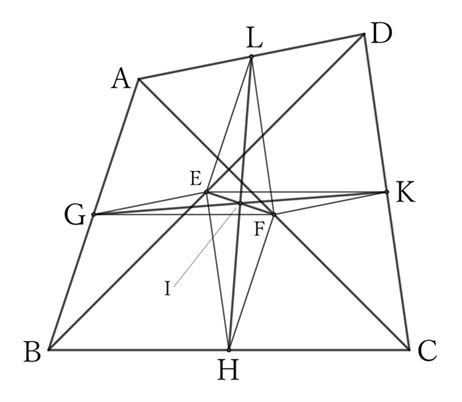The lines joining the midpoints of two pairs of opposite sides of a quadrilateral intersect at the midpoint of the line segment joining the midpoints of the two diagonals.
$\downarrow$ $\downarrow$ $\downarrow$ $\downarrow$ $\downarrow$
$$ $$Solution

Let the midpoints of $AB, \ BC, \ CD, \ DA, \ BD$ and $AC$ be $G, \ H, \ K, \ L, \ E$ and $F$, and the midpoint of $EF$ be $I$.
$△BDA$ and $△BEG$ share $∠ABD \ (=∠GBE)$,
$$AB∶GB=BD∶BE=2∶1,$$
$$∴ \ △BDA∼△BEG,$$
$$∴ \ DA∶EG=2∶1,$$
$$∴ \ EG=\frac{1}{2} DA. \qquad [1]$$
$△CDA$ and $△CKF$ share $∠ACD \ (=∠FCK)$,
$$AC∶FC=CD∶CK=2∶1,$$
$$∴ △CDA∼△CKF,$$
$$∴ \ DA∶KF=2∶1,$$
$$∴ KF=\frac{1}{2} DA. \qquad [2]$$
From $[1]$ and $[2]$,
$$EG=KF. \qquad [3]$$
Similarly,
$$GF=EK. \qquad [4]$$
From $[3]$ and $[4]$, since the quadrilateral $EGFK$ is a parallelogram, its diagonal $GK$ passes through the midpoint $I$ of the other diagonal $EF$.
Similarly, since the quadrilateral $EHFL$ is a parallelogram, its diagonal $HL$ passes through the midpoint $I$ of the other diagonal $EF$.
Therefore, the lines $GK$ and $HL$, connecting the midpoints of two pairs of opposing sides of the quadrilateral $ABCD$, intersect at the midpoint $I$ of the line segment $EF$, which connects the midpoints of the two diagonals $AC$ and $BD$.
Reference Teiichiro Sasabe (1976) The Encyclopedia of Geometry (2nd edition), Seikyo-Shinsha, p.45.